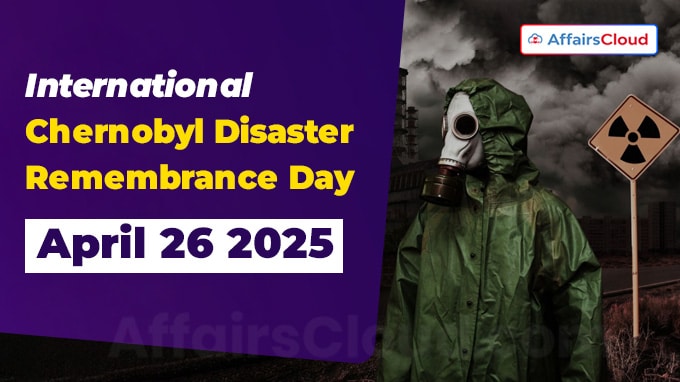 The United Nations (UN)’s International Chernobyl Disaster Remembrance Day is annually observed across the globe on 26th April to commemorate the anniversary of the 1986 Chernobyl nuclear disaster.
The United Nations (UN)’s International Chernobyl Disaster Remembrance Day is annually observed across the globe on 26th April to commemorate the anniversary of the 1986 Chernobyl nuclear disaster.
- The day is observed to honour the victims and survivors of the Chernobyl disaster and to raise awareness about its long-lasting impacts.
- 26th April 2025 marks the 39th anniversary of the Chernobyl nuclear disaster.
Background:
i.On 8th December 2016, the United Nations General Assembly (UNGA) adopted the resolution A/RES/71/125 and proclaimed the 26th April of every year as International Chernobyl Disaster Remembrance Day.
ii.The 1st ever International Chernobyl Disaster Remembrance Day was observed on 26th April 2017.
About the Chernobyl Disaster:
On 26th April 1986, a routine 20-second shutdown at the Reactor Number 4 of Chernobyl Nuclear Power Plant in, Ukraine, in the former Soviet Union (now the territories of Belarus, Ukraine, and Russia) resulted in a catastrophic explosion, releasing 520 radionuclides including iodine-131, cesium-137, and strontium-90, into the atmosphere.
Extent of Contamination:
i.Human Impact: Nearly 8.4 million people across Belarus, Ukraine, and Russia were exposed to harmful radiation, leading to increased cases of thyroid cancer, leukemia, and other chronic illnesses.
ii.Geographical Spread: Approximately 155,000 square kilometers (sq. km) of land, equivalent to half the size of Italy, was contaminated.
iii.Agricultural Loss: Around 52,000 sq. km of farmland, larger than Denmark, was affected by long-lived radioactive isotopes like cesium-137 (30-year half-life) and strontium-90 (28-year half-life).
iv.Displacement: Nearly 404,000 people were resettled, with millions continuing to live in contaminated areas, facing ongoing health and social challenges.
v.The Chernobyl disaster is one of the two nuclear accidents rated as Level 7 (major accident) on the International Nuclear and Radiological Event Scale (INES), alongside the Fukushima Daiichi nuclear accident in Japan in 2011.
Note: A Level 7 event signifies a major release of radioactive material with widespread health and environmental effects.
UN’s Involvement in Recovery:
i.In 1990, the Soviet Government recognized the need for international assistance, prompting significant UN action:
ii.The UNGA adopted resolution A/RES/45/190 in 1990, calling for global cooperation to mitigate the disaster’s consequences. An Inter-Agency Task Force was established to coordinate efforts.
iii.In 1991, the Chernobyl Trust Fund was created under the United Nations Office for the Coordination of Humanitarian Affairs (UN OCHA) to expedite financial contributions for recovery projects.
Shift in Strategy:
In 2002, the UN shifted its focus from emergency humanitarian aid to a long-term developmental approach:
- The United Nations Development Programme (UNDP) took the lead, collaborating with regional offices in Belarus, Ukraine, and Russia to promote sustainable recovery.
- In 2009, the UN launched the International Chernobyl Research and Information Network (ICRIN) to support sustainable development programs and provide information on healthy lifestyles in affected regions.




